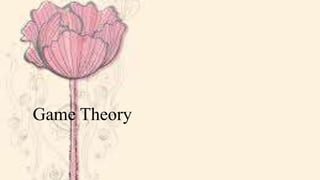
Unit II A - Game Theory
- 1. Game Theory
- 2. Syllabus Introduction Two person Zero-sum Games Maximin and Minimax Principles Mixed Strategies, Expected Pay-Off Solution of 2 x 2 Mixed Strategy Game Solution of 2 x 2 Mixed Strategy Game by the method of oddments Dominance Principle Graphical method for solving a 2 x n game
- 3. Introduction There are two opposite parties with conflicting interests, and the action of one depends upon the action which the opponent takes. The outcome of the situation is controlled by the decisions of all the parties involved is termed a competitive situation. Example: All sort of activities, in games, sports, business, economic, political, social and military fields.
- 4. Conflict over time: The generic term used to characterize these situations is games. Participants -> Competitors is “ The success of one is usually at the expense of the other”. Each participant selects and executes those strategies. He / She believes will results in his “Winning the game”. The participants make use of deductive and inductive logic in determining a strategy for winning.
- 5. Theory of games started in 20th century. “John Von Neumann and Morgenstern” in 1944 published their “Theory of games and economic behavior”. Von Neumann’s approach “The minimax principle”. It involves the fundamental idea of the minimization of maximum loss. A competitive situation is called a game.
- 6. Four properties: Players There are a finite number of competitors Game involving n persons is called n person game. Game interests of only two parties may be in conflict is called two person game. A list of finite or infinite number of possible course of action each called a strategy, is available to each player. The list need not be the same for each player. The strategy of a player is the pre-determined rule by which a player decides his course of action from his own list during the game.
- 7. Two types of strategies Pure strategy One knows in advance all strategies, out of which he always selects only one particular strategy. This choice is made irrespective of the strategy others may choose. Mixed Strategy A Player decides in advance his courses of action in accordance with some fixed probability distribution.
- 8. Advantages The mixed strategy over the pure strategy is that a player has only finite choices of pure strategies but he has infinite number of mixed strategies. A play is played when each player chooses one of his courses of action. The choices are assumed to be made simultaneously, so that no player knows his opponent’s choice until he has decided his own course of action.
- 9. Pay-Off Every play is a combination of courses of action is associated with an outcome, which determines a set of gains, one to each player. A loss is considered as a negative gain. Thus, after each player of the game, one player pays to other an amount determined by the courses of action chosen. A pay-off matrix is a table which shows how payments should be made at the end of a play or the game.
- 10. Two person zero-sum games A game with two players in which the gain of one player is equal to the loss of the other.
- 11. Zero-sum game: A game in which the gains of one player are the losses of the other players. Example: The algebraic sum of gains to all players after a play is bound to be zero.
- 12. Example 18.1 Player B Strategy B1 Strategy B2 Player A Strategy A1 Player A Wins 2 Player A Wins 3 Strategy A2 Player B Wins 1 Player B Wins 2
- 13. Solution Player B B1 B2 Player A A1 2 3 A2 -1 -2
- 14. A wins the game only by playing his strategy A1 A1 plays all the time. B realizes that A will play strategy A1 all the time and in an effort to minimize A’s gains, plays his strategy B1. The solution to the game is A1, B1. A wins 2 points and B loses 2 points each time the game is played. The value of the game is A is 2 and B is -2.
- 15. Optimal Strategies It provides the best situation in the game in the sense that it provides maximal pay-off to the players.
- 16. Value of the game The expected outcome per play when the players follow their optimal strategy. It is generally denoted by V. A game, whose value is zero, is called a fair game. By solving a game, to find the best strategies for both the players and the value of the game.
- 17. Maximin and minimax principles A player lists his worst possible outcomes and then he chooses that strategy which corresponds to the best of these worst outcomes. The best strategies for each player on the basis of the maximin and minimax criterion of optimality. MAXIMIN = MAXIMUM (ROW, MINIMUM) MINIMAX = MINIMUM (COLUMN, MAXIMUM)
- 18. Saddle-point situation It guarantees that neither of the player is tempted to select a better strategy. Pay-off to A > max(i) min(j) aij Pay-off to B < min(j) max(i) aij If the maximin value for a player is equal to the minimax value for another player is max(i) min(j) aij = min(j) max(i) aij The game is said to have a saddle point and the corresponding strategies are the optimal strategies. The amount of pay-off at the saddle point is the value of the game V max(i) min(j) aij = min(j) max(i) aij = V It can be recognized because it corresponds to both the smallest numerical value in its row and the largest numerical value in its column.
- 19. If a game has a saddle point, then the pure strategies corresponding to the saddle point are the optimal strategies and the number at that point is the value of the game.